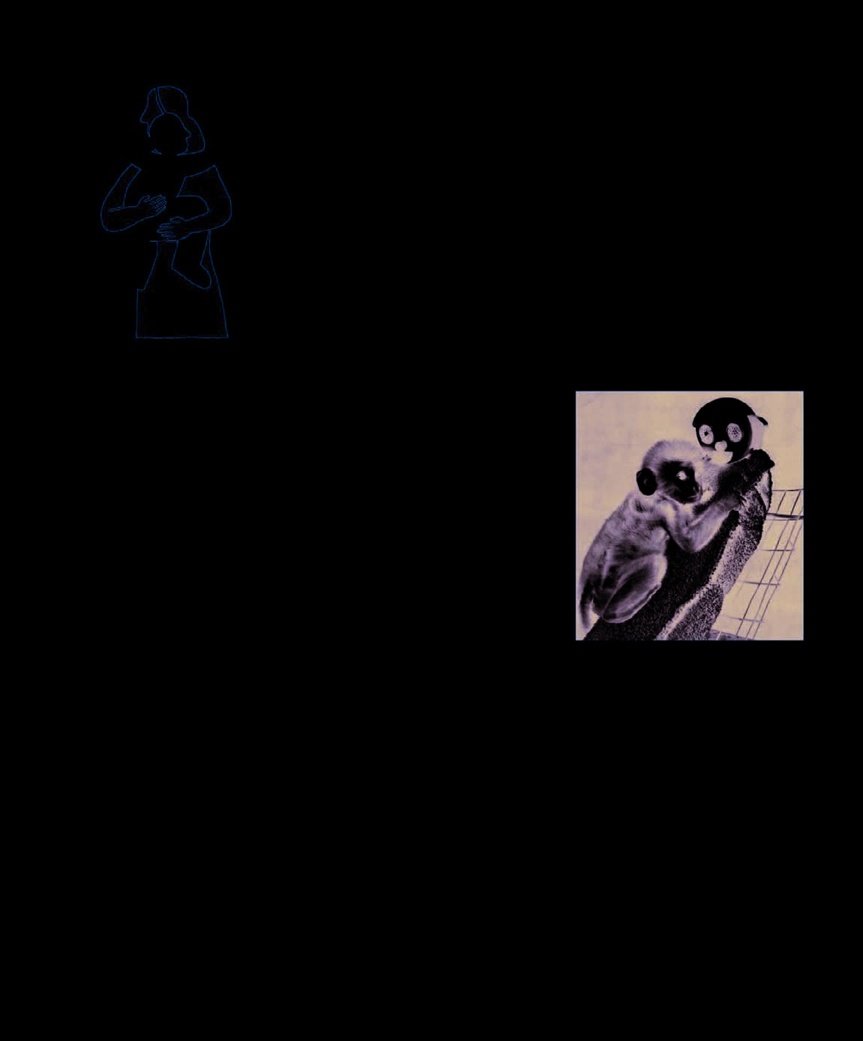The Psychology Book (87 page)
Read The Psychology Book Online
Authors: Unknown

consequences in later life. He also
figure. The term he gave for this
argues that there is a critical period
tendency to attach to a female is
during which a mother and infant
“monotropy,” and he emphasized
should develop a secure attachment:

276 JOHN BOWLBY
Bowlby predicted that child
evacuees
would suffer long-term
attachment problems as a result of
enforced separation from their mothers;
later studies found this to be the case.
sanatorium (which offered no
substitute mothering) when they
had been less than four years old.
The children—aged seven to 13 by
the time of the study—were rougher
in play, showed less initiative and
more over-excitement, and were less
competitive than those with a more
traditional upbringing.
In extreme cases, Bowlby found
that maternal deprivation could even
result in “affectionless psychopathy,”
a clinical condition in which people
are unable to care deeply for others
The reason why this primary, secure
by supporting the mother financially
and so do not form meaningful
attachment is so important, Bowlby
and emotionally. The evolutionary
interpersonal relationships. Those
says, is that it is essential for the
basis of Bowlby’s theory suggests
who suffer from it display a higher
development of an inner working
that women are naturally inclined
incidence of juvenile delinquency
model or framework that the child
to be parents, with inborn maternal
and antisocial behavior without any
uses to understand himself, others,
instincts that guide them through
sign of remorse, since they are
and the world. This inner working
the process of child-rearing, whereas
unable to experience feelings of guilt.
model guides a person’s thoughts,
men are more naturally suited for
In Bowlby’s 1944 study of juvenile
feelings, and expectations in all of
being providers.
thieves, he found that many of the
his personal relationships, even into
However, British psychologist
young criminals had been separated
adulthood. Because the primary
Rudolph Schaffer—who worked
from their mothers for a period of
attachment serves as a prototype
under Bowlby at the Tavistock
more than six months before they
for all future relationships, the
Clinic in London—found that there
were five years old, and of these,
quality of the attachment will
is considerable cultural variation
14 had developed the condition of
determine whether or not a child
in the extent to which fathers are
affectionless psychopathy.
grows to trust others, view himself
involved in childcare. Increasing
as valuable, and feel confident in
numbers of fathers are taking on
society. These working models are
the role of principal parent, which
resistant to change; once formed,
suggests that parenting roles are
they determine how people behave
a consequence of social convention
and the kind of bond they will form
rather than biology.
with their own children.
Bowlby’s view implies that men
Attachment behavior is
will inevitably be inferior parents,
held to characterize
The father’s role
but research by Schaffer and the
human beings from the
Bowlby’s attachment theory has
American psychologist Ross Parke
cradle to the grave.
been criticized for exaggerating the
suggests that men are equally
John Bowlby
importance of the mother–child
capable of providing warmth and
relationship and undervaluing
sensitivity to their infants. They
the father’s contribution. Bowlby
also found that a child’s
sees the father as having no direct
developmental outcome is not
emotional significance for the
determined by the parent’s gender,
infant, contributing only indirectly
but rather by the strength and

DEVELOPMENTAL PSYCHOLOGY 277
mothers; they should stay with the
child, fulfilling the role of essential
primary caregiver. For decades
after Bowlby’s theory was posited,
generations of working women
were saddled with guilt, but many
Direct observations
studies since then have questioned
of men in their fathering
this aspect of Bowlby’s theory. For
role has shown them
instance, in the 1970s psychologists
to be as capable of as
Thomas Weisner and Ronald
much warmth and
Gallimore showed that mothers are
sensitivity as women.
the exclusive caregivers in only a
H. Rudolph Schaffer
very small percentage of human
societies, and it is not uncommon
Bowlby claimed that day care
for groups of people (including
centers
are not suitable for the care of
relatives and friends) to share
infants, because maternal deprivation
responsibility for raising children.
leads to juvenile deliquency; this created
Schaffer also points to evidence
a real dilemma for working mothers.
suggesting that children of mothers
quality of the bond that is forged.
who are happy in their work
have used Bowlby’s basic premise
In a further study, Schaffer and
develop more successfully than
to delve more deeply into childhood
psychologist Peggy Emerson found
children whose mothers are
attachment patterns, and to develop
that infants and young children
frustrated from staying at home.
theories of adult attachment by
display a wide range of attachment
exploring how the bond between
behaviors toward many people
Groundbreaking work
parent and child can influence the
besides their mothers, and that
Despite the many criticisms and
future bond between spouses and
multiple attachments may actually
revisions that it has provoked,
romantic partners. Bowlby’s
be the rule rather than the exception.
Bowlby’s work remains the most
theories have also had many
These later findings were
comprehensive and influential
beneficial effects on various
especially important for working
account of human attachment to
aspects of child-rearing, such as
women, because the implication of
date, and led to the groundbreaking
the improvement of institutional
Bowlby’s theories was that women
experiments of Harry Harlow and
care and the growing preference
should not work once they become
Mary Ainsworth. Psychologists
for fostering as an alternative. ■
John Bowlby
John Bowlby was the fourth of six
Longstaff, with whom he had
children born to a London-based,
four children. After the war he
upper-middle-class family. He was
became director of the Tavistock
raised primarily by nannies and
Clinic, where he remained until
sent to boarding school at the age
retirement. In 1950 he carried
of seven. These experiences made
out a major study for the World
him particularly sympathetic to
Health Organization. He died at
the attachment difficulties faced
his summer home on the Island
by young children. He studied
of Skye in Scotland, aged 83.
psychology at Trinity College,
Cambridge, then spent some time
Key works
teaching delinquent children. He
later earned a medical degree and
1951
Maternal Care and
qualified as a psychoanalyst.
Mental Health (WHO Report)
During World War II, Bowlby
1959
Separation Anxiety
served in the Royal Army Medical
1969, 1973, 1980
Attachment
Corps and in 1938 married Ursula
and Loss
(three volumes)

278
CONTACT COMFORT
IS OVERWHELMINGLY
IMPORTANT
HARRY HARLOW (1905–1981)
IN CONTEXT
APPROACH
M
any psychologists have
suggested that an infant
becomes attached to its
caregiver simply because that
Attachment theory
person fulfils its need for food. John
BEFORE
Bowlby challenged this “cupboard
love” idea theoretically, but Harry
1926
Sigmund Freud’s
Harlow set out to prove it.
psychoanalytic theory of
Harlow took infant macaque
“cupboard love” suggests that
monkeys from their mothers, placing
an infant becomes attached
them in cages with surrogate
to a caregiver because that
“mothers”—one made of wire with
person is a source of food.
a feeding bottle attached; the other
1935
Konrad Lorenz states
made of soft, cuddly, terry cloth, but
nonhumans form strong bonds
with no bottle. If the “cupboard
with the first moving object
love” theory was correct, the baby
Infant macaque monkeys
in
they meet—often the mother.
monkeys would remain with the
Harlow’s experiment formed a
mother that provided food. But in
strong attachment to their cuddly,
1951
John Bowlby argues that
fact, they spent most of their time
cloth, surrogate “mother,” despite her
human mothers and infants
inability to provide any nourishment.
with the cloth mother, using her as
are genetically programmed to
a secure base, and clinging to her
form a uniquely strong bond.
for safety when frightening objects
Harlow’s work was enormously
were placed in the cage. Later
important, because contemporary
AFTER
tests, in which the cloth mother
advice from psychologists and
1964
UK psychologists Rudolf
was also able to rock and provide
doctors had warned parents
Schaffer and Peggy Emerson
food, showed this attachment was
against rocking or picking up a